True Grit: Hawthorne
July – August 2019
War, water, and wishes led Hawthorne to a bright future.
BY MEGG MUELLER
A person with true grit is often defined as someone who sticks to their goals, despite problems, setbacks, and failures. Having true grit means you are tough and determined…you have a steadfast core. In 2019, we are highlighting towns in Nevada that have that core strength. Not all towns in Nevada have huge shiny tourist draws; many exist along the highways that traverse our state but aside from getting gas or grabbing food to go, they are easily overlooked. Nevada roads go on forever. Small towns appear on the horizon, but are often quickly in the rearview mirror with little more than a passing thought about the town’s existence. And while tourism is the state’s largest industry—and the focus of this magazine—it is not why all towns in Nevada exist. This year, we honor some of those towns that defy easy description but stand tall in the desert, refusing to give into the sways of economic hardship or the passing of time. These towns bloom in the dirt, and they embody true grit. This issue: Hawthorne.
The Silver State has seen many towns come and go; ghost towns litter the state and have been said to outnumber live towns 6 to 1. While many living towns have seen their fortunes rise and fall, and their populations swell and dwindle, very few have felt it the way Hawthorne has.
Most towns experienced a boom and bust in the late 1880s-early 1900s, but Hawthorne had its growing pains much later. In fact, it wasn’t until World War II when Hawthorne saw its population peak. Before 1944, the town—which had been founded in 1881—hadn’t been home to more than 1,000 people, and often had just a few hundred. But that was soon to change.
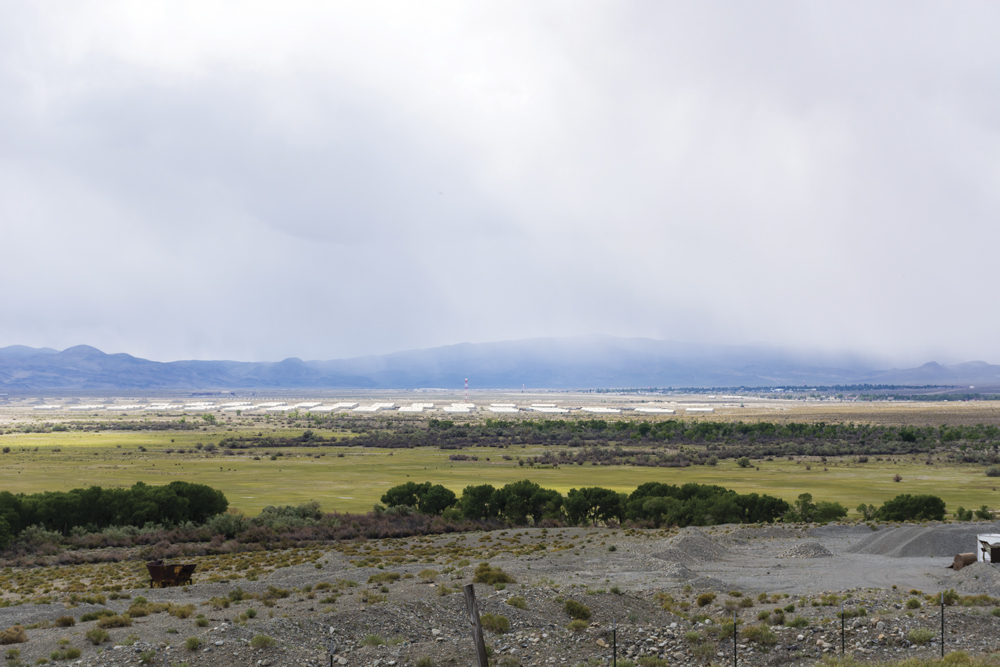
IT STARTS THE SAME
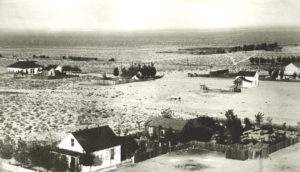
In 1880, the Carson & Colorado Railroad planned a 600-mile route to connect the Carson and Colorado rivers while running through prolific mining districts. While only 300 miles of that ill-fated narrow-gauge railway were ever laid, the town of Hawthorne was born as a division point for the railroad. The town’s location in the Walker Lake Valley was determined by railroad mules, who during a terrible winter found the most protected spot. Hawthorne became the county seat of Esmeralda County in 1883, despite it having just a few hundred residents. While mining was going on in the nearby mountains, the economic windfall was minimal, and in 1905, when the railroad—now part of the Southern Pacific—changed to standard gauge, the town was bypassed entirely. Goldfield became the new county seat, and Hawthorne carried on with mining discoveries maintaining a slim economy for about 500 residents.
In 1911, the massive Esmeralda County was determined to be too large, and Mineral County was born. Hawthorne became the seat of the new county, giving the courthouse and economy new life, but as mining waned after World War I, only about 200 people were hanging on.
Then in 1926, misfortune in New Jersey turned into a lifesaver for Hawthorne. Lake Denmark, New Jersey housed a naval ammunition depot until an explosion decimated it. Congress was on the hunt for cheap real estate and Hawthorne was chosen to house the new depot.
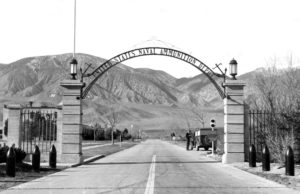
Construction began in 1928, and the first high explosives were delivered in 1930. The base brought people and troops to town slowly at first, but with the onset of World War II, Hawthorne’s role in the conflict saw the town explode to 13,000. The depot was a staging area for bombs, rockets, and ammunition. After the war, the depot settled into peacetime mode, and Hawthorne saw its citizens dip to less than 1,900 by 1950.
In 1977, the Navy transferred the base to the Army, and today, the Hawthorne Army Depot—a government owned, contractor-operated facility—is the largest in the world, with a mission to “store conventional munitions; demilitarize and dispose of unserviceable, obsolete, and surplus munitions; and maintain serviceability through inspection and renovation to ensure munitions readiness.”
NOT JUST BUNKERS ON THE HORIZON
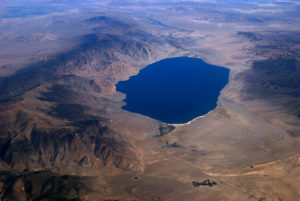
While the depot is the largest feature in Hawthorne—it sits on 147,236 acres, has 414 buildings, and 2,094 magazines that provide an explosive storage capacity of 7,685,000 square feet—it is not the most scenic. Although the site of the bunkers laid across the valley can elicit an eerie Cold War vibe, the beauty of the Walker Lake Valley lies in Walker Lake. Like the town’s population, it too has dwindled over the years.
The lake’s source of water—Walker River—has been diverted for agricultural use for so long, the lake’s surface elevation has dropped more than 150 feet since the 1880s. The loss of fresh water has also increased salinity in the lake and has made it uninhabitable for fish and most wildlife.
Chris Hegg, chairman of the Mineral County Board of Commissioners, grew up in nearby Luning and knows the lake well, and its importance to the local economy. Without the fishing and boating that once attracted visitors to the lake, an economic resource dried up for Hawthorne. But he’s hopeful the problem is on the mend. The county recently won a long-awaited court decision that, among other things, reallocates water from Walker River to be delivered to Walker Lake.
“We are not sure if we’re going to get it on this cycle of water, or not,” Chris says. “There are still some decisions and allocations to be made. Luckily, we’ve been getting a reprieve with the weather the last few years so we’ve seen the water level being sustained. We’re holding.”
Chris explains the court’s decision gave not only water rights back to the lake, but allows the county to purchase additional rights from ranches that have them to sell. To see the fish return, he says the lake needs to come up about 6-9 feet to have it be considered healthy, and right now, they have the water rights to make that happen once delivery begins.
Janice and Jim Scott have lived in Hawthorne more than 70 years, and Janice recalls when her friends would jump from the cliffs that dotted the western side of the lake when water levels were high.
“I wouldn’t do it,” she says, laughing, “but in high school, everyone used to love jumping in.”
The demise of Walker Lake extends beyond devastating wildlife; it also took away one of the great recreational treasures of the area. A place where families and friends communed and visitors came to watch the annual boat races and throw a line in the water. When that stopped, the livelihood for local hotels and restaurants all but disappeared with the dropping water lines.
The return of Walker Lake, conversely, could see all of those things return, along with something Chris says is equally important: a place people want to call home.

IF YOU BUILD IT, WILL THEY COME?
Hawthorne is in the midst of the vicious circle that plagues many small towns. Which comes first in the perfect scenario: businesses and recreational activities come to town, creating an exciting, diverse place for families looking to put down roots; or, families come to town for good paying jobs and businesses follow due to increased demand for goods and services? Finding the right formula is elusive and tricky, Chris notes. Mineral County is seeing an increase in mining, including a number of pending mines near Hawthorne, and these mines are bringing big paychecks with them. Trouble is, Chris admits, getting workers whose families want to relocate to a town with no bowling alley or movie theater.
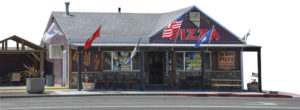
The depot may come into play in the near future however. The civilian contract is up for bid, and with a new contractor, there is the promise of new businesses opening on land the base has to sell. And new business is something the county definitely wants to attract.
From solar and geothermal power to hemp farms, Mineral County is looking for businesses and they have one thing nearby counties no longer have: lots of county land for sale. An increase in small businesses means more jobs, more workers. More workers lead to more money spent in the local economy, including housing. The need for more businesses comes with the influx of people, and more business stops more traffic coming through town. Traffic, for its part, is already on the increase, Chris says, thanks to trucks serving Storey County’s Reno-Tahoe Industrial Park, and could be growing even more in the near future.
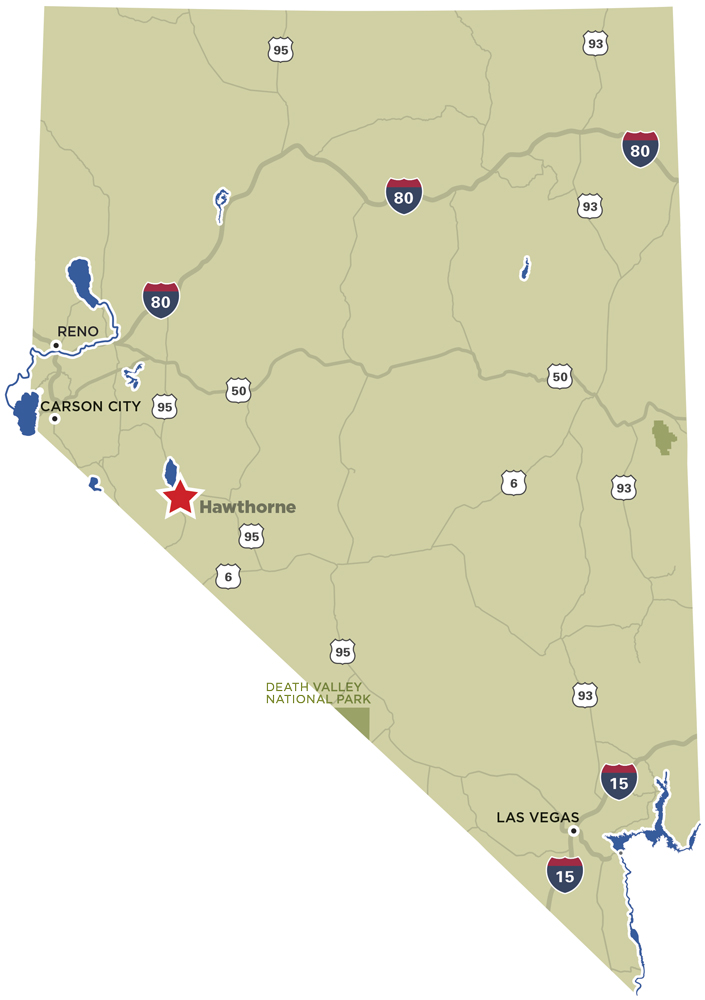 “Interstate 11 is a big topic right now,” he says. “We are almost sure it’s coming through Mineral County, but the question is how close will it be. We don’t want it too far away, or no one will stop here.”
“Interstate 11 is a big topic right now,” he says. “We are almost sure it’s coming through Mineral County, but the question is how close will it be. We don’t want it too far away, or no one will stop here.”
The Scotts used to own a gas station and convenience store, among other businesses, and Janice recalls always being delighted at the number of foreign accents she’d hear among her patrons.
“This is a busy town,” she says. “People from all over the world come through here.”
Chris agrees, noting that between 6,000-7,000 trucks pass through Hawthorne on any given day. Getting them to stop for gas and a meal is key, and hopefully, they stop for even longer.
IT’S HOME
Betty Easley came to town in 1965, and it was her final stop. She worked as a teacher until retiring in 1992. She had a transient childhood, moving every four years with her Baptist minister father and her mother. After college, she followed her folks once more to Hawthorne and her traveling days were over.
“It has been so nice to put down roots here after a life of moving,” she says. “I love the fact it’s a quiet town. I do hate that a lot of businesses have struggled, but we’re really hoping the base will be opening up for some private industry.”
Betty serves as the Hawthorne airport’s volunteer greeter/pilot liaison, something she started doing in 2007. Her title may be unofficial, but Betty’s passion for promoting the airport and her town is nothing short of legit. Knowing general aviation pilots have many airports to choose from, Betty has created an environment that brings them back to town time and again. On her own, she’s purchased three courtesy vehicles for pilots to use when they are in town, giving them the opportunity to visit Hawthorne for a meal or to see a museum.
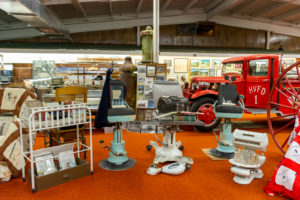
Encouraging visitors and having the infrastructure to support their needs is crucial, everyone agrees. Keeping families, and especially young children, in town is the only way for Hawthorne to survive and grow. When Janice graduated high school, there were 95 kids in her class. A few years later, when her sister Janette Childress graduated, there were 85. This year’s class has just 30 kids. The Scott’s daughter lives in town and has worked for the hospital for 10 years, but their son is working on a career in the music industry, so the opportunities in Las Vegas made more sense. They have two grandchildren who live in town also, and they understand that young people need to have options when it comes to jobs and a social life, but they think that can be found in Hawthorne. Jim worked at the depot after he got out of the army, but eventually he and Janice made their own way with a series of family businesses.
“We love it here,” Janice says. “We have always been content to be here.”
Betty agrees.
“So many people in this town are nice and friendly. I don’t think the town’s problems are unique, and we still have hope.”
“With I-11 coming through, there are probably going to be a couple of offramps. If we can get water to the lake, we get the fish back. We know we’re going through hard times, but it will get better. We know it will.”
OUR FAVORITE PLACES IN HAWTHORNE
El Capitan Casino/Travelodge
540 F St.
Hawthorne, NV 89415
elcapcasino.com, 775-945-3321
Old Nevada Pizza
497 E St.
Hawthorne, NV 89415
775-945-2550
Mineral County Museum
400 Tenth St.
Hawthorne, NV 89415
web2.greatbasin.net/~mcmuseum, 775-945-5142

